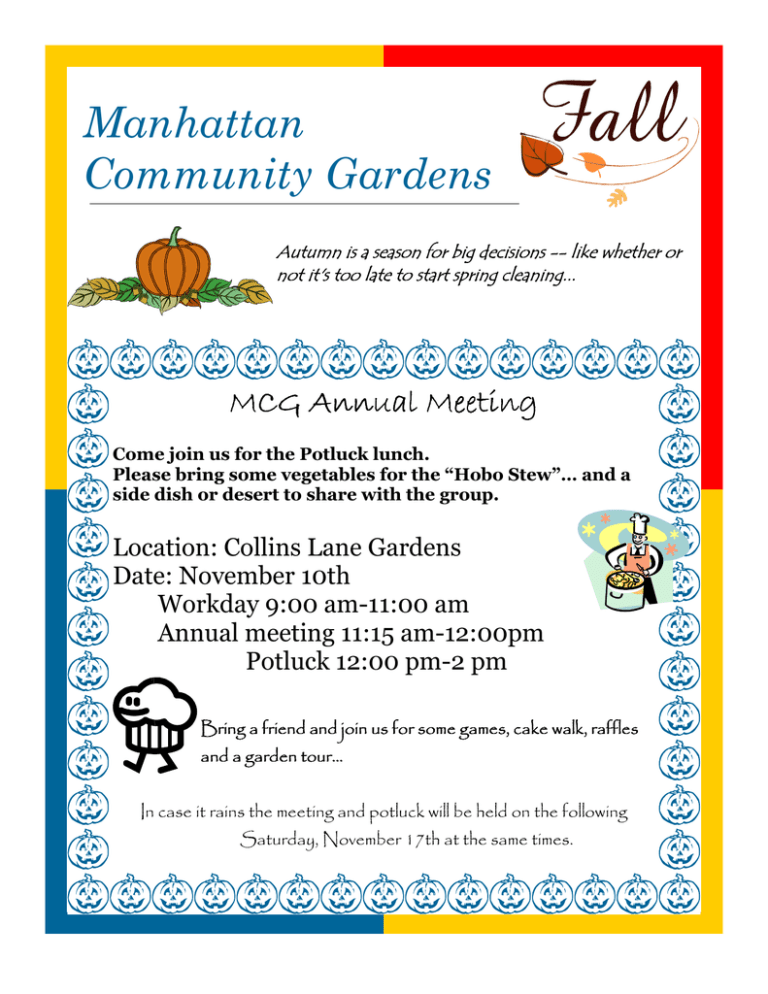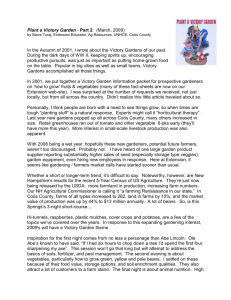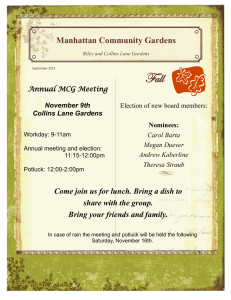Manhattan Community Gardens
advertisement

Manhattan Community Gardens Autumn is a season for big decisions -- like whether or not it's too late to start spring cleaning... MCG Annual Meeting Come join us for the Potluck lunch. Please bring some vegetables for the “Hobo Stew”… and a side dish or desert to share with the group. Location: Collins Lane Gardens Date: November 10th Workday 9:00 am-11:00 am Annual meeting 11:15 am-12:00pm Potluck 12:00 pm-2 pm Bring a friend and join us for some games, cake walk, raffles and a garden tour… In case it rains the meeting and potluck will be held on the following Saturday, November 17th at the same times. Page 2 Manhattan Community Gardens MCG-version of the “American Gothic” Al Schmaderer enjoying the swing at the Collins Lane gardens. The swing was made by our one and only John Rodgers! Thank you!! SMALL CHILDREN? THEN COLLINS LANE IS FOR YOU! Parents, if you haven’t yet been out to see our Collins Lane garden site, I hope you get a chance soon to check out our family-friendly alternative to Riley Lane! With no traffic, no unknown passersby, and no loud and dangerous trains, gardening at Collins Lane will be a safer and more enjoyable experience for you and your young children! At Collins Lane you’ll find a peaceful oasis in a gorgeous park-like rural setting. There are picnic tables, plenty of shade trees, grassy areas, flower gardens, a butterfly garden, and we hope to have a sandbox soon. Early next season we also hope to have a family-themed Social at Collins Lane, so that our gardening families can get to know each other. Want to see the Collins Lane garden site for yourself? Only 5 minutes from Riley Lane gardens, it’s easy to get there by driving south on Manhattan Avenue, turn right on Collins Lane and you’ll see the gardens on your left in about ¼ mile. The gate is kept locked, so, before going, email me at communitygarden@tryufm.org for the gate combination or ask any Board member. Returning gardeners can have up to 3 plots at Collins Lane and we do not expect you’ll have any problems getting a plot(s) since we’ll have 72 new ones (25’ x 25’) in 2013! Cybil Perkins—Board Member Manhattan Community Gardens Page 3 Thank You!!! One of our gardeners, Keith Swanson made picnic tables for the MCG gardens. We greatly appreciate his contribution to our “break from gardening” areas. BEWARE!!! THE END OF THE WORLD (GROWING SEASON) IS NOT NEAR While the growing season is over for most of our spring crops – red tomatoes, the green and yellow squash, multicolored beans, etc. – many plants are continuing to grow and prosper. While many gardeners have given up on their gardens, those pesky weeds and grasses are just hitting their stride in growing. As I walk through the gardens, I see that many of you have started to or have cleaned up your plots getting rid of old plants and growth. You may think you are done for the year, but you still have a job to do until the first hard freeze hits. Grass and weeds will continue to flourish during the next two to three months (the late summer and fall seasons). In less than a week, they can mature and begin to seed. Often, these problems can occur in small areas within your plots. This is the problem. When you fail to maintain your garden until that hard freeze, you become a problem for all of the gardeners. The grasses and weeds will produce hundreds (maybe more) of seeds that will blow and migrate into your neighbors gardens. Even worst, they will sit there in your plot and cause you problems next season. Please continue to control the grass and weeds in your plot until the first hard freeze. This is just being a good neighbor. I will continue to monitor the garden plots over the next several months. If I see a problem with grass and weeds in your plot(s), I will contact you. If you do not maintain your plots for the entire growing season and fail to respond to warnings about weeds and grasses in your plots, your plot could be declared abandoned. If it is, you lose the plot (s) and your deposit. Also remember, the areas of your plot that abut your neighbor’s plots and the paths and open areas and roads are your responsibility. These areas are just as productive in producing seeds that will prosper next year and become a problem for all of us. Please include these areas in your clean up times. Please help me to avoid being the “BAD GUY”. Keep you plot clean for the rest of the growing season. If you think the end is here, it could be the end of your plot. Thank you. Thomas Fuller Ron Downey—Vice-President “Many things grow in the garden that were never sown there.” Page 4 Manhattan Community Gardens Collins Lane Garden: Yesterday – Today – Tomorrow Yesterday A year ago a new garden area for the Community Gardens was just a dream. The discussion about the loss of the North area in Riley Lane was just emerging. The pending changes could have turned into a lament about loss. Your Board chose to see it as a great opportunity. After an extensive search of potential garden sites, Collins Lane was identified as this opportunity. Riley County, as the owner of this site, was more than willing to work with us to turn what was a vacant lot into our new garden. The site had been a trailer park before the 1993 flood. After it was destroyed by the flood, the lot was cleared and declared a flood plain. Riley County was more than willing to lease the lot to the Garden with some restrictions associated with it being a flood plain. Thus began the new garden. Today With the generosity and hard work of many individuals and organizations, a new garden area started to emerge. A pressing need was a water source. Howie’s Recycling contributed the equipment and dug the well. It also helped to clear the first two acres of trees and other vegetation. An army of volunteers tilled the first acre, laid out the plots, put in the roads, found the sheds and prepared and stocked them with tools and equipment, and other tasks like cleaning up the poison ivy, and keeping the general area clean. The gardeners prepared their plots and the growing season was great. Tomorrow We are preparing the second acre of plots for next growing season and expect that they will also be full with new gardeners for the spring of 2013. The Community Garden Board is now starting a planning process for the FUTURE development of Collins Lane. We need your help w i t h t h i s p r o c e s s ! If you would like to be a part of the planning process please contact John Rodgers (rodgersjohn@rocketmail.com). If you have ideas about what we should do to in the future, please send this to John. We have a great opportunity to do many things to develop a great garden, please help us to do this. Manhattan Community Gardens Page 5 Gardening in 2013!!! Save these dates... Registration for Returning Gardeners: Dates: Wednesday, December 12th (6-8pm) Tuesday, January 8th (6-8pm) Location: Portoff Hall—Cico Park—Manhattan, KS You can also register by mail to UFM or at the UFM office after December 13th. Registration forms are available online from the MCG website. If you want to keep your current plots— the last day to register will be January 12th, 2013. Please let us know if you are NOT planning on gardening next year so we can make your plot available for a new gardener, by email to communitygarden@tryufm.org Registration for New Gardeners: Dates: Sunday, January 27th (3-5pm) Monday, February 4th (6-8pm) Wednesday, February 27th (6-8pm) Location: Portoff Hall—Cico Park—Manhattan, KS Gardening Class Instructors needed! Share your gardening skills with others in the community by teaching a class through UFM Community Learning Center! Gardening classes of particular interest are organic gardening, composting, vegetables, annuals and perennials and container gardening. Classes are being set up now for the Spring semester. Contact Kayla Oney, UFM Education Coordinator at 785-539-8763 or kayla@tryufm.org to find out more about offering a gardening class through UFM. Page 6 Manhattan Community Gardens Growing Mushrooms Outdoors A frequently overlooked vegetable for the community gardener to try is the Mushroom. This is not as daunting a task as some may assume as the requirements are not significantly different from what most of our crops require. A patch of land, compost/wood chips, straw or coffee grounds, mushroom spawn (your seed for the crop), water and your on your way to raising to your first crop of "Shrooms. Mushroom spawn is inexpensively obtained from a commercial company that any internet search engine can find for you. Just enter the term, mushroom spawn supplier, and then have fun clicking on the links and studying the results. It's the online version of reading a seed catalog, but specifically for mushroom starters. Some folks might wonder at this point why you aren't running the risk of growing "undesirable" mushrooms with an outdoor bed. First of all, Know your Mushrooms. After studying the catalogs and placing your order you should be familiar with the appearance of the variety you've chosen to cultivate. Most commercial varieties you will have access to do not look similar to anything lethal or inedible. Unless your growing Agaricus campestris ( the white mushrooms commonly found in cans and grocery stores) which could resemble some of the poisonous Aminitaes, there should be little if any chance for confusion to arise. Secondly, by following the growers instructions for how much spawn to use to inoculate what size bed, your mushroom spawn should out compete any wild competitors that might blow in on the wind. Thirdly, if in doubt, just throw it out. There are a number of different cultivation systems we can use in Manhattan but today we'll start with an outdoor mushroom patch. This wiil require that you set aside some defined square footage, let's say 4' x 4'. Next dig out the soil to a depth of 2" to 4" and set this beside your "patch". Depending upon what you've chosen to grow, and there are many choices such as Pearl Oyster Mushrooms in wheat straw, coffee grounds or newspapers (be sure the paper is printed using non-toxic inks), Shaggy Manes in compost, King Stropheria in fresh hardwood (alder, elm, maple, oak, poplar,etc.) chips, Shitake in hardwood sawdust and so forth. Article continued on page 7 Manhattan Community Gardens Page 7 Growing Mushrooms Outdoors continued Avoid aromatic conifers such as cedar and pine for wood chips as these contain natural fungicides that will inhibit, if not kill, your spawn. Now fill your patch with the selected substrate (compost, straw, wood chips, etc.) for growing your mushrooms and bring to soil level. Next sprinkle your mushroom spawn across the surface of your new bed and then cover with another 2" - 4" of the selected substrate. Finally cover the top of the bed with the soil you removed previously and then begin watering. The soil will keep your bed from drying out rapidly in hot weather and/or full sun but you don't want so much that your mushrooms are unable to reach the surface and fruit. Some growers may not recommend a soil covering for your bed in which case the soil you've removed can be returned to other parts of your garden and you'll add another 2"-4" of substrate and begin your watering regimen. The bed should never be allowed to dry out fully to the depth of the prepared bed. Usually watering whenever you water the rest of your garden will be sufficient. Depending upon the variety you've planted, you may begin harvesting within 6 months or it may take as long as 2 years. Once established your bed should remain productive for anywhere from 1-2 years or longer. Next time we'll cover using plug spawn to inoculate logs and stumps to cultivate a variety of mushrooms that includes, Maitake, Chicken of the Woods, Lion's Mane, which are fruiting across Kansas right now, and the ever popular, and rather expensive, Shitake Mushroom. Bryant Kruger—Board Member Manhattan Community Garden c/o UFM 1221 Thurston Street Manhattan KS 66502 785-539-8763 www.tryufm.org What’s Inside MCG Annual Meeting Small Children? Then Collins Lane is for you! Beware! The End of the Growing Season is Not Near Collins Lane Gardens Gardening in 2013!! Gardening Class Instructors needed! Thank You Gardeners! Growing Mushrooms Outdoors We appreciate your efforts and dedication to the Community Gardens.




